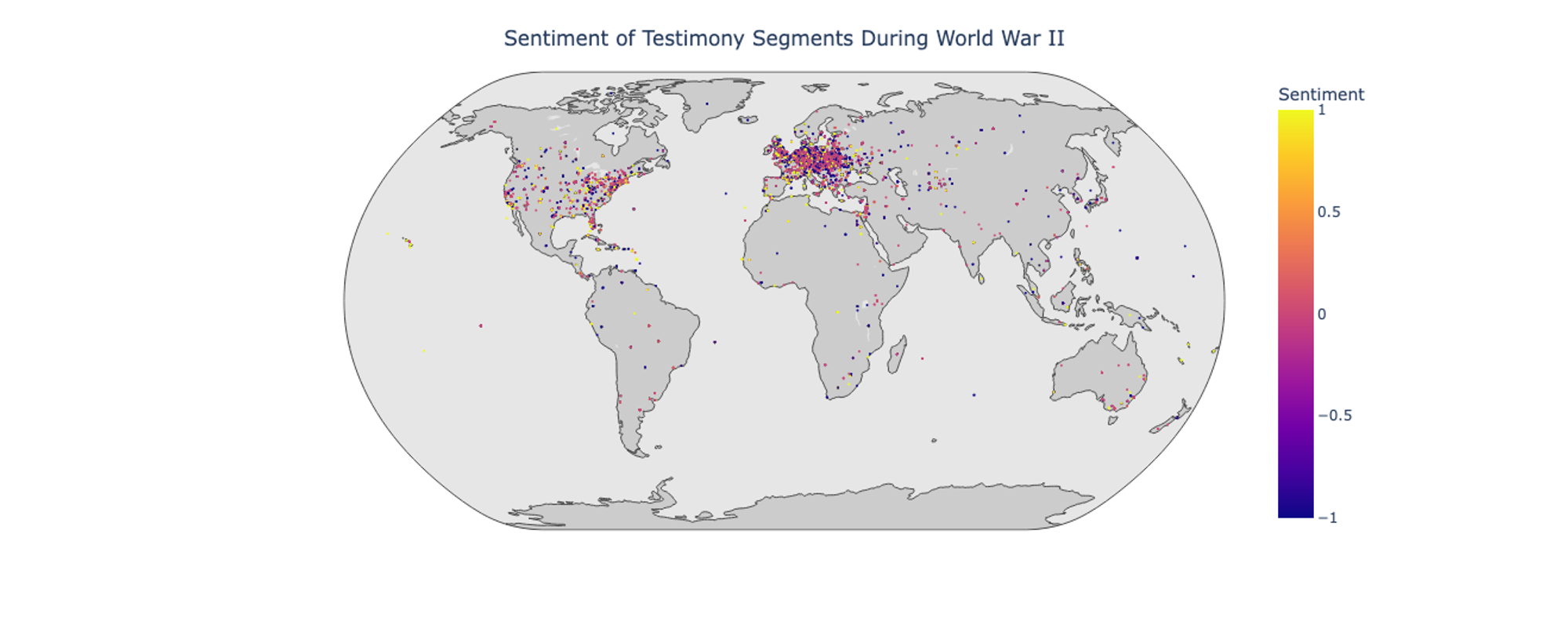
Geographies of Affect–Place and Sentiment in Holocaust Testimonies
The Holocaust was the state-sponsored genocide of European Jews and millions of others by the German Nazis during World War II. This global event tore apart families and involved far reaching processes of displacement, concentration, deportation, dislocation, and relocation. As a result of its nature, experiences and survivor stories of the Holocaust involve both widely shared traumas, as well as unique, heterogeneous individual testimonies. Thus, the memories associated with survivors’ personal experiences through the events of the Holocaust are incredibly emotionally complex and nuanced.
Historians and researchers have attempted to study the scale and complexity of the Holocaust through oral histories and testimonies. In 1954, David Boder studied the frequency and magnitude of trauma in oral testimonies by manually annotating transcripts from oral histories. Boder’s study used an exponential scale to categorize traumata. The scale took into consideration multiple dimensions of experience, including whether trauma events were witnessed directly or indirectly.
Contemporary sentiment analysis tools lack the level of nuance and dedication to detailed description that Boder exhibited. Sentiment analysis tools are limited in multiple dimensions, including inabilities or ineffective accounts for tone, sarcasm, negations, comparatives, and multilingual data, and these weaknesses are enhanced especially when applied to complex texts in digital humanities.
More recently, Blanke et al. (2020) used neural networks to assign positive or negative sentiments to testimony segments. This approach to sentiment analysis involved using a combination of dictionary based methods and machine learning to construct a dataset of negative and positive text segments drawn from Holocaust testimonies. Blanke et al discovered negative word embeddings associated with places. Specifically, Blank et al investigated what words are associated with “camp” and they reported that “The model of negative memories includes the camps ‘Buchenwald’, ‘Auschwitz’, ‘Mauthausen’, ‘Dachau’, etc.”
While these findings reinforce our knowledge of the atrocious events of the Holocaust, high level representations of associations between words does little to bring into relief the complexity of affect surrounding these sites. As Kushner has argued, “For survivor oral testimony to be utilized to its full potential” it would require “the strands of history and memory to be woven together to show the full complexity of survivor identity.” It should not be overlooked that while many gruesome acts occurred at camps, they were also places where many survivors lived for several years and experienced a wide range of emotions, despite the traumatic conditions to which they were subjected. In reading testimonies, it is possible to find more emotionally complex and multidimensional depictions of camp life. For example, in a testimony from Holocaust survivor Isaac Levy, he recalls:
One dynamic little man by the name of Yossele Rosensaft was the moving, moving figure in this. He was indestructible. He’d been pushed from one camp to another and survived. He stood about 5 foot 2 in his socks, but energy beyond recognition.(File: 8610, Time Code: 0:41:00)
It is important to acknowledge that camps were not only sites of genocide, but they were also sites of liberation. As expressed in Sabina Wagschal’s testimony:
Yes. She was liberated by the Russians. They came to the camp. And the Russians, in her case, were her liberators.(File: 1965, Time Code: 1:17:00)
Furthermore, while concentration camps and death camps are a common site discussed in Holocaust testimonies, these were not the only camps that Holocaust survivors experienced. Another crucial element of survivor’s experiences are refugee camps, which also cannot be reduced to negative memories. Malka Baran recalls memories from the refugee camp in their testimony as follows:
A little bit. Uh, I studied English at home a little bit and after the camps a little bit. I even taught a little bit of English in the B camp, in the displaced person camp. And when I came here, I studied, uh, very seriously in college, though I– and I like to read, so I read English books. That helped me a lot. (File 24470, Time Stamp: 1:40:00)
Thus the finding that sentiment is embedded in the language that surrounds places should be understood not as a definitive reduction of place to sentiment, but rather as an opportunity to study the relationship between sentiment and place in more depth. Such a study should take into consideration that places are neither passive nor static containers of history. Places and their spaces are active and dynamic sites that can both change and produce changes. As Knowles, Cole and Giordano (2014) argue, “Holocaust was implemented through space and not merely in space.” With these concerns in mind, the focal point of our interest is: how can digital humanities address the complexity and geographic scale of emotional experiences of Holocaust survivors?
Read the full paper here: https://www.automatedfutures.net/geographies-of-affect-place-and-sentiment-in-holocaust-testimonies/
